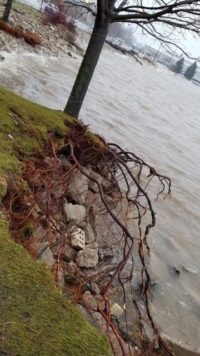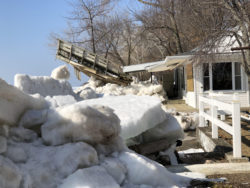RipRap & Sea Walls – Pros and Cons
Living on a body of water can be a great experience. Those experiences include fishing, boating, or just enjoying the natural beauty of the area. It’s the ideal way to escape the heat and congestion of the city. Plus, how can you beat the sunsets?
At the same time, living on the water also means you are vulnerable to nature and all she can throw at you – including erosion.
In recent years erosion has become the most significant problem waterfront property owners have experienced. Record-setting water levels and more destructive storms are projected to continue for years.
Along with the high waters and intense storms has come – EROSION!!!
How has it affected the beachfront?
High water has affected everyone’s beachfront, and this, in turn, affects your property values. The intensity of the storms has increased along with the high water. It is not uncommon to see sand beaches disappear, trees wash out, walls collapse, and the water encroaching on lawns. Many people have lost entire beaches, and the water is right up against the grass. Even the daily wave action destroys your beachfront.
This summer alone, we have seen hillsides sliding down due to ground saturation and base erosion. Stairways are being destroyed, and beaches are disappearing due to the high water and wave action.
How do you prevent erosion?
There are two ways to protect property from waves – Seawalls and riprap.
Of the two methods, seawalls are the more expensive method. Many times, due to the underlying solid rock, a seawall is not an option.
As an alternative, riprap becomes your best solution to protect your shoreline.
Erosion happens when waves move along the beach. The constant movement begins to remove smaller pieces of the beach and washes them away. Without these small pieces packed on the beach holding the larger stones in place, the larger pieces begin to move, and eventually, they too are washed away.
Vegetation, lawns, and tree roots are undermined. Once the soil is gone, nothing is stopping the erosion, and the tree will fall over.
Wave action contains a lot of energy. For example, try standing against the waves during a strong wind on the shoreline when the waves break. Be prepared to get knocked over. The energy in the waves will exceed what you can resist.
Riprap breaks up that energy by providing numerous cavities for the water. The more holes, the better. Every time the water enters one of those cavities, the wave losses some of its energy. With hundreds of “cavities” breaking up the wave, the destruction is eliminated or substantially reduced.
A properly installed riprap “wall” dissipates the energy and does not allow for removal of the small parts that start the whole cycle.
Does RipRap work?
Check out this YouTube video. Watch closely at 40 seconds and in particular, stop around 2:25 minutes.
The house on the right has a seawall. Note the waves are splashing back from the wall and note the “turmoil” in the sand.
To the left of the same house is riprap. When you put the video in motion, you will see the white breaking waves dissipate into the riprap like it’s supposed to with no “turmoil” in the sand.
Still further left, you see unprotected property erosion.
Finally, you get to a house protected by riprap. Does riprap work? You be the judge.
What DOESN’T RipRap prevent?
Riprap will not prevent flooding or ice flows.
Some argue that a seawall is the only way to stop an ice flow. It’s time to reconsider that idea.
A seawall protected this property. The ice piled up against the wall and stopped. Great!
But then, more ice came in and worked its way over the first layer at the wall. But it didn’t stop there. The ice continued to pile up until it went OVER the wall and across about 50 feet of lawn and started this destruction.
Would riprap have changed things? Probably not! The difference is – You would have spent less money for the same result.
What’s the life expectancy of riprap and seawalls?
Seawalls typically last an average of 30-35 years. However, the use of galvanized metals means they will usually last a few years longer.
Riprap usually outlasts their steel counterparts. Given the proper attention and maintenance, both of these seawalls should last a “lifetime.”
Riprap acts as an energy dissipator, which means the openings in the rock absorb the energy from the waves. (See the Youtube video above.) Seawalls deflect the waves to prevent erosion. Riprap absorbs and spreads the energy in an array of voids and openings. The wave energy dissipates when the waves enter the voids in the rock.
Enhancement of Property
Unlike steel, aluminum, wood, or vinyl seawalls, riprap blends into the environment around it. It becomes part of it. The organic material meshes with the surrounding area.
When it comes time to assess your property values, it will play a significant role. Your property will be measured based on its overall appearance, and the natural look from rip rap adds to it.
Riprap acts as a natural barrier between your property and the waves. Even though it is protecting the shoreline, it may protect your home as well.
Easy to Maintain
The natural appeal and design of rip rap also offer an easier way to preserve the seawall. Where steel can rust, wood can rot, and vinyl can warp and deform, riprap only needs occasional maintenance.
After a massive storm or sudden change in hazardous weather conditions, such as snow and ice storms, you need to check on the riprap. Sometimes, a few of the rocks will be displaced. If they are, you simply need to re-arrange them to maintain the seawall’s integrity. No heavy equipment needed.
Furthermore, because the rocks are placed randomly, it makes replacing them that much easier.
If steel rusts, it means a bigger section will have to be dug out and replaced through cutting and welding.
Wood rot can lead to termites infesting the entire seawall.
But with riprap, a quick change of a few rocks will keep your property safe!
However, a seawall’s makeup isn’t the only factor determining its longevity.
Pros of a Riprap Retaining Wall
Here is why a riprap “wall” works well for those who live on a body of water.
- Riprap Walls Protect Against Erosion
The rocks used in a riprap design absorb the flow and motion of water. Reduce the movement against your shoreline, and the shoreline will not break down.
2. RipRap is Easy to Maintain
An essential aspect of owning a seawall is proper upkeep. Maintenance of a riprap design requires an annual inspection. If you check the riprap rocks for rock movement at least once a year, then the seawall should stand the test of time. It is a good idea to check on the rocks after major storms or weather-related incidents.
Replacement of the rocks is also easy. Because they are individually placed, when one stone starts to wear down, you only have to relocate that one. There’s no welding or digging involved.
3. RipRap is Eco-Friendly
The natural exterior of riprap also promotes eco-friendliness.
The rock placement protects vegetation. Plants can grow in between the rocks for a more natural look.
4. RipRap Lasts for A Long Time
If you keep up on the annual maintenance of your riprap rock wall, it will work for a lifetime. Riprap is durable and long-lasting. That means that while proper upkeep is essential, you can rest knowing that your riprap seawall has a lifespan of decades.
5. RipRap Enhances Property
Because it is more natural-looking than a steel seawall, riprap blends into the environment. The individual rocks give off a natural look that improves the aesthetic beauty of your property and home.
6. It also has the benefit of increasing property value by protecting your shoreline. Therefore, the investment of putting in a riprap retaining wall will pay off if you ever decide to sell your home.
Cons of a Riprap Retaining Wall
While riprap seawalls offer several fantastic benefits, there are a few potential drawbacks to keep in mind.
- Rip-Rap is An Investment
If the damage is minor, it can be fixed relatively easily with basic tools. Some issues are more severe and require more than just routine maintenance.
For example, if your steel seawall is sagging, dipping, or bowing outward, then there’s a good chance you need serious repair work, if not replacement.
And if you see indentations, pits, or holes forming near the seawall, then a breach in the wall may be allowing the soil to drain through. In this case, the wall would require significant repairs.
2. Rip-Rap Depends on Your Location
It might turn out that riprap isn’t the best seawall for you merely because of where you live. Riprap is most effective in areas with high-velocity waters. If you live on a calmer body of water, a different seawall might be the one you want.
Do You Need Help Picking the Perfect Seawall?
Protecting your home and property from erosion and flooding is a necessity. You want your seawall to stand up to these harmful elements. That means you want it installed correctly. So, why not let the professionals do it for you?
In Conclusion
Contact PIER & WATERFRONT SOLUTIONS TODAY! Contact Dave @ 920-905-2588 or use this simple quote request FORM.
Tell Your Friends & Family
Have friends or neighbors you believe should see this article? Email them this article – and Thank you!
You can visit Pier & Waterfront Solutions on Facebook also.
Don’t Forget – PWS is the expert when you have a waterfront problem!
Where is Pier & Waterfront Solutions?
Located at 7325 St. Hwy 57, we are about 3 miles south of Sturgeon Bay, and 1 mile past the intersection of Cty MM (heading north). Look for the intersection of Idlewild Road and Hwy 57.
ARE WE OPEN?
Pier & Waterfront Solutions has remained “open.” We have implemented measures to ensure the safety of our employees and visitors. As of Aug 1st, Wisconsin mandates the use of face masks. It’s the only known method to control the spread at this time.
While all this is going on, we are working to maintain the trusted service you expect. That’s important to us.
We are conducting as much business as possible by email, text, or phone. Site visits will continue as usual. When in-person contacts are necessary, we follow “social distancing” guidelines as closely as possible.
Call, message, or use this simple request form to get answers and quotes.
Thank you for allowing us to work with you – safely.







